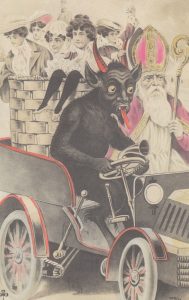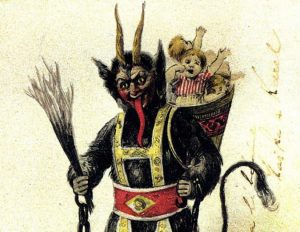
Fewer Christmas traditions are stranger than that of Krampus. Krampus, as you may be aware, is St. Nicholas’s sinister (and lesser-known) demonic sidekick. If old St. Nick is the good cop who rewards well-behaved children with gifts of toys, Krampus is his bad cop counterpart: he punishes naughty children by beating them with birch switches (and by terrifying them with his demonic visage). Truly unlucky troublemakers might be kidnapped away in the basket he carries strapped to his back. The tradition recalls the old trope of saints vanquishing demons through the power of God and forcing them into their thrall, but likely has deeper roots in pre-Christian Alpine customs.
Many Americans remain unfamiliar with Krampus, although his profile has grown in recent years (owing in part, no doubt, to the 2015 holiday horror film of the same name). But he is widely celebrated across several parts of Europe, including Austria, Bavaria, Hungary, and surrounding regions. Young men in these parts will traditionally dress up as Krampus in the first two weeks of December, particularly on the evening of 5 December (the night before the Feast of St. Nicholas), and roam the streets frightening children with rusty chains and bells. So grab your mask, hit the streets, and get in the Krampusnacht spirit — just be prepared for some weird looks if you’re not in Europe.



